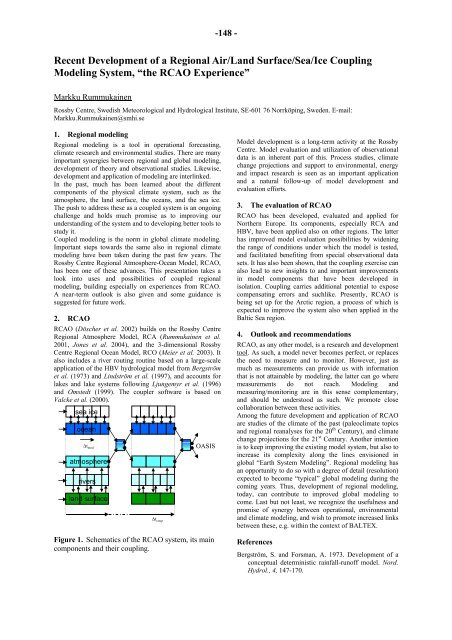Fourth Study Conference on BALTEX Scala Cinema Gudhjem
Fourth Study Conference on BALTEX Scala Cinema Gudhjem
Fourth Study Conference on BALTEX Scala Cinema Gudhjem
You also want an ePaper? Increase the reach of your titles
YUMPU automatically turns print PDFs into web optimized ePapers that Google loves.
-148 -<br />
Recent Development of a Regi<strong>on</strong>al Air/Land Surface/Sea/Ice Coupling<br />
Modeling System, “the RCAO Experience”<br />
Markku Rummukainen<br />
Rossby Centre, Swedish Meteorological and Hydrological Institute, SE-601 76 Norrköping, Sweden. E-mail:<br />
Markku.Rummukainen@smhi.se<br />
1. Regi<strong>on</strong>al modeling<br />
Regi<strong>on</strong>al modeling is a tool in operati<strong>on</strong>al forecasting,<br />
climate research and envir<strong>on</strong>mental studies. There are many<br />
important synergies between regi<strong>on</strong>al and global modeling,<br />
development of theory and observati<strong>on</strong>al studies. Likewise,<br />
development and applicati<strong>on</strong> of modeling are interlinked.<br />
In the past, much has been learned about the different<br />
comp<strong>on</strong>ents of the physical climate system, such as the<br />
atmosphere, the land surface, the oceans, and the sea ice.<br />
The push to address these as a coupled system is an <strong>on</strong>going<br />
challenge and holds much promise as to improving our<br />
understanding of the system and to developing better tools to<br />
study it.<br />
Coupled modeling is the norm in global climate modeling.<br />
Important steps towards the same also in regi<strong>on</strong>al climate<br />
modeling have been taken during the past few years. The<br />
Rossby Centre Regi<strong>on</strong>al Atmosphere-Ocean Model, RCAO,<br />
has been <strong>on</strong>e of these advances. This presentati<strong>on</strong> takes a<br />
look into uses and possibilities of coupled regi<strong>on</strong>al<br />
modeling, building especially <strong>on</strong> experiences from RCAO.<br />
A near-term outlook is also given and some guidance is<br />
suggested for future work.<br />
2. RCAO<br />
RCAO (Döscher et al. 2002) builds <strong>on</strong> the Rossby Centre<br />
Regi<strong>on</strong>al Atmosphere Model, RCA (Rummukainen et al.<br />
2001, J<strong>on</strong>es et al. 2004), and the 3-dimensi<strong>on</strong>al Rossby<br />
Centre Regi<strong>on</strong>al Ocean Model, RCO (Meier et al. 2003). It<br />
also includes a river routing routine based <strong>on</strong> a large-scale<br />
applicati<strong>on</strong> of the HBV hydrological model from Bergström<br />
et al. (1973) and Lindström et al. (1997), and accounts for<br />
lakes and lake systems following Ljungemyr et al. (1996)<br />
and Omstedt (1999). The coupler software is based <strong>on</strong><br />
Valcke et al. (2000).<br />
sea ice<br />
ocean<br />
∆t mod<br />
atmosphere<br />
rivers<br />
land surface<br />
∆t coup<br />
OASIS<br />
Figure 1. Schematics of the RCAO system, its main<br />
comp<strong>on</strong>ents and their coupling.<br />
Model development is a l<strong>on</strong>g-term activity at the Rossby<br />
Centre. Model evaluati<strong>on</strong> and utilizati<strong>on</strong> of observati<strong>on</strong>al<br />
data is an inherent part of this. Process studies, climate<br />
change projecti<strong>on</strong>s and support to envir<strong>on</strong>mental, energy<br />
and impact research is seen as an important applicati<strong>on</strong><br />
and a natural follow-up of model development and<br />
evaluati<strong>on</strong> efforts.<br />
3. The evaluati<strong>on</strong> of RCAO<br />
RCAO has been developed, evaluated and applied for<br />
Northern Europe. Its comp<strong>on</strong>ents, especially RCA and<br />
HBV, have been applied also <strong>on</strong> other regi<strong>on</strong>s. The latter<br />
has improved model evaluati<strong>on</strong> possibilities by widening<br />
the range of c<strong>on</strong>diti<strong>on</strong>s under which the model is tested,<br />
and facilitated benefiting from special observati<strong>on</strong>al data<br />
sets. It has also been shown, that the coupling exercise can<br />
also lead to new insights to and important improvements<br />
in model comp<strong>on</strong>ents that have been developed in<br />
isolati<strong>on</strong>. Coupling carries additi<strong>on</strong>al potential to expose<br />
compensating errors and suchlike. Presently, RCAO is<br />
being set up for the Arctic regi<strong>on</strong>, a process of which is<br />
expected to improve the system also when applied in the<br />
Baltic Sea regi<strong>on</strong>.<br />
4. Outlook and recommendati<strong>on</strong>s<br />
RCAO, as any other model, is a research and development<br />
tool. As such, a model never becomes perfect, or replaces<br />
the need to measure and to m<strong>on</strong>itor. However, just as<br />
much as measurements can provide us with informati<strong>on</strong><br />
that is not attainable by modeling, the latter can go where<br />
measurements do not reach. Modeling and<br />
measuring/m<strong>on</strong>itoring are in this sense complementary,<br />
and should be understood as such. We promote close<br />
collaborati<strong>on</strong> between these activities.<br />
Am<strong>on</strong>g the future development and applicati<strong>on</strong> of RCAO<br />
are studies of the climate of the past (paleoclimate topics<br />
and regi<strong>on</strong>al reanalyses for the 20 th Century), and climate<br />
change projecti<strong>on</strong>s for the 21 st Century. Another intenti<strong>on</strong><br />
is to keep improving the existing model system, but also to<br />
increase its complexity al<strong>on</strong>g the lines envisi<strong>on</strong>ed in<br />
global “Earth System Modeling”. Regi<strong>on</strong>al modeling has<br />
an opportunity to do so with a degree of detail (resoluti<strong>on</strong>)<br />
expected to become “typical” global modeling during the<br />
coming years. Thus, development of regi<strong>on</strong>al modeling,<br />
today, can c<strong>on</strong>tribute to improved global modeling to<br />
come. Last but not least, we recognize the usefulness and<br />
promise of synergy between operati<strong>on</strong>al, envir<strong>on</strong>mental<br />
and climate modeling, and wish to promote increased links<br />
between these, e.g. within the c<strong>on</strong>text of <strong>BALTEX</strong>.<br />
References<br />
Bergström, S. and Forsman, A. 1973. Development of a<br />
c<strong>on</strong>ceptual deterministic rainfall-runoff model. Nord.<br />
Hydrol., 4, 147-170.













